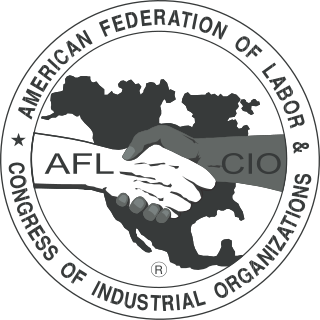Related Research Articles
A trade union or labor union, often simply referred to as a union, is an organization of workers whose purpose is to maintain or improve the conditions of their employment, such as attaining better wages and benefits, improving working conditions, improving safety standards, establishing complaint procedures, developing rules governing status of employees and protecting and increasing the bargaining power of workers.

The World Federation of Trade Unions (WFTU) is an international federation of trade unions established in 1945. Founded in the immediate aftermath of World War Two, the organization built on the pre-war legacy of the International Federation of Trade Unions as a single structure for trade unions world-wide, following the World Trade Union Conference in London, United Kingdom.

The American Federation of Labor and Congress of Industrial Organizations (AFL-CIO) is a national trade union center that is the largest federation of unions in the United States. It is made up of 60 national and international unions, together representing more than 12 million active and retired workers. The AFL-CIO engages in substantial political spending and activism, typically in support of progressive and pro-labor policies.

The United Steel, Paper and Forestry, Rubber, Manufacturing, Energy, Allied Industrial and Service Workers International Union, commonly known as the United Steelworkers (USW), is a general trade union with members across North America. Headquartered in Pittsburgh, the United Steelworkers represents workers in Canada, the Caribbean, and the United States. The United Steelworkers represent workers in a diverse range of industries, including primary and fabricated metals, paper, chemicals, glass, rubber, heavy-duty conveyor belting, tires, transportation, utilities, container industries, pharmaceuticals, call centers, museums, and health care.

The Glass, Molders, Pottery, Plastics and Allied Workers International Union (GMPIU) was a labor union representing craft and industrial workers primarily in the ceramics, china, craft metals, fiberglass, glass, insulation, and pottery industries, in the United States and Canada.
The Trade Unions International of Building, Wood, Building Materials and Industries, also known as the Trade Unions International of Construction, Wood, Building Materials and Industries, or by its French acronym UITBB is a Trade Union International affiliated with the World Federation of Trade Unions.

The Trade Unions International of Chemical, Oil and Allied Workers was a trade union international affiliated with the World Federation of Trade Unions. It was often known by its French initials, ICPS.

The Italian Federation of Wood, Building and Allied Workers is a trade union representing construction workers in Italy.
The Italian Railway Union was a trade union representing railway workers in Italy.
The Italian Federation of Hauliers and Inland Waterway Workers was a trade union representing transport workers in Italy.
The Italian Transport Federation is a trade union representing workers in the transport sector in Italy.
The United Italian Federation of Clothing Workers was a trade union representing workers in the clothing and footwear industries in Italy.
The Federation of Chemistry was a trade union representing workers in chemical and related industries in Italy.
The Italian Federation of Book Workers was a trade union representing printing workers in Italy.
The National Federation of Sharecroppers and Smallholders was a trade union representing self-employed farmers in Italy.
The Italian Union of Chemical and Allied Industries was a trade union representing workers in the chemical and mining industries in Italy.
The Italian Federation of Hat Workers was a trade union representing hatters in Italy.
The International Brotherhood of Pottery and Allied Workers (IBPAW) was a labor union representing workers in the pottery industry in the United States and Canada.
References
- ↑ "La nostra storia". FILCA. Retrieved 3 August 2020.
- ↑ Mitchell, James P. (1955). Directory of Labor Organizations: Europe. Washington DC: United States Department of Labor. p. 17.1–17.24.
- ↑ Ebbinghaus, Bernhard; Visser, Jelle (2000). Trade Unions in Western Europe Since 1945. Basingstoke: Palgrave Macmillan. pp. 405–408. ISBN 0333771125.
- ↑ "Chi siamo". FILCA. Retrieved 3 August 2020.
- 1 2 3 4 5 6 7 8 9 "I Segretari generali". FILCA. Retrieved 3 August 2020.